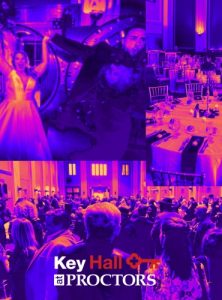Our history
From Vaudeville to Broadway and beyond
Community began rallying around ‘musty white elephant’ in 1970s; $40 m. expansion key in early 2000s
Since 1926, Proctors, in the heart of downtown Schenectady, has presented the very best in entertainment for the Capital Region.
At the turn of the 20th century, Frederick Freeman Proctor, known as the “Dean of Vaudeville,” managed many successful theaters throughout the eastern half of the United States. His first in Schenectady, leased in 1912, sat alongside the Erie Canal. By 1919, the strength of General Electric and the American Locomotive Company prompted a population increase of over 80,000 in the city, which influenced Proctor to build a larger, more grandiose venue in the ‘uptown’ business area. Soon after, he purchased real estate at 432 State Street, and in 1925, construction began on what promised to be his most sensational vaudeville hall.
To design his new jewel, Proctor hired renowned theatre architect Thomas Lamb. Lamb’s Italian Baroque style and Egyptian influences would be showcased beautifully in the elaborate designs that illuminated the new vaudeville and movie palace. On April 14, 1925, ground was broken for the new venture. Onlookers observed the construction progress every day for a year and a half, as steelwork was put into place and framework was covered with brick and roofing. The interior included an ornate plaster ceiling and decorative moldings, gold accents, plush carpeting, a giant chandelier, and an elaborate ceiling mural created by the famed Danish painter, August Lundberg. An arcade with shops, businesses, and a side entrance to the Carl Company department store was also built, extending from State Street through to Smith Street. When Proctors was completed, the total cost of construction totaled $1.5 million.
Opening day on Dec. 27, 1926 attracted more than 7,000 paid admissions, beginning with the purchase of the first ticket by twelve-year-old Michael Riccio. Those entering for the first time were overwhelmed by their surroundings. Tapestries covered the walls, an imported Louis XV marble fireplace graced the mezzanine, a Rococo organ stood ready to accompany silent films, and faux marble columns enhanced the splendor of the dazzling showroom. Backstage, 18 spacious dressing rooms, each with a private bath, awaited anxious performers. The feature film on opening day was a seven-reeler, “Stranded in Paris,” starring Bebe Daniels. It was paired with five vaudeville acts. A matinee performance cost 35 cents, and an evening show 50 cents.
Although movies learned to talk in 1927, sound was not perfected until the early 1930s, hastening the decline of vaudeville, which essentially died out by the next decade.
But during the 1930s and 40s—the Golden Age of Hollywood and the big band era—Proctors still flourished. Movies like “King Kong,” “The Wizard of Oz,” and “Gone With the Wind” drew crowds that numbered in the thousands. Music greats like Cab Calloway and Duke Ellington graced the MainStage, as did comedians Bob Hope and Red Skelton. Blackstone the Magician and tenor John McCormack were also among the many notables performing on stage during this era.
Proctors holds the distinction of being the site for the first public demonstration of television. Dr. Ernst F. W. Alexanderson, one of General Electric’s most prolific inventor-engineers, conducted the experiment. On May 22, 1930, before a live audience, and witnessed by scientific writers from around the country, an orchestra in the pit was led by the image of a conductor on a seven-foot screen transmitted across the city from a GE lab. A plaque commemorating this historic event is located in the Arcade.
Ironically, it was the invention of television that would eventually jeopardize the future of the theatre beyond vaudeville. After World War II, cultural hubs across America were adversely affected by the population shift toward suburbia, the growth of shopping malls and the marketing of a TV for every home. During the 1950s and 60s, Proctors was primarily a movie house, but it had fallen into such disrepair that its future looked bleak.
By the 1970s, Proctors had changed hands multiple times, and was eventually taken over by the city of Schenectady after a foreclosure for nonpayment of taxes by a previous owner. It appeared for a time that Proctors would have to be shuttered indefinitely, perhaps demolished, as its tarnished elegance was seen as a liability for the city. Second-run films and an occasional touring show could not support what some called “a musty white elephant” and its ever-growing operating costs.
Various performing arts groups and concerned individuals, though, felt Proctors was a valuable asset to the community, as it had historic significance and the potential to become a spectacular home for the arts once again. Courageously, these citizens came together in the summer of 1977 to form the Arts Center and Theatre of Schenectady, Inc. for the purpose of saving Proctors from the wrecking ball. However, by Feb. 1978, the city had closed the building again for nonpayment of taxes.
With help from the community, ACTS was able to fund a $25,000 feasibility study, which showed that Proctors could be valuable to the community once again. In order to make the theatre habitable, ACTS needed money for necessary initial repairs. The group held a successful fundraiser, called “Proctors is Alive and Well,” which raised over $7,000. In addition, approximately $500,000 in federal and city funds was made accessible for restoring and making Proctors operationally safe. A 13-strong Schenectady Employment and Training Administration crew erected a maze of scaffolding to clean, paint, and re-plaster. A new roof, three new boilers, a sprinkler system, and safety railings on the balcony and orchestra pit were installed. Dedicated volunteers took over cleaning the 2,700 seats, which were much too costly to replace.
Proctors was officially reborn on Jan. 3, 1979. A standing-room-only audience for magician Harry Blackstone, Jr.—son of the famous vaudevillian who played Proctors in its early days—heard Mayor Frank Duci proclaim, “This is a significant, historic moment,” as he presented the theatre’s key and deed to Mrs. Katherine S. Rozendaal, president of ACTS. She in turn gave him one dollar, the price agreed upon by both parties for the purchase. That same year, the Charlie Daniels Band was the first rock act to perform at Proctors. Almost four decades later, Proctors averages 1,700 uses of the campus per season, from Broadway hits to opera, ballet, pop stars, and comedy favorites.
Rather than completely shut down the theatre during renovations, Proctors chose to remain open and allow the community to take an active role in the restoration. One program strongly supported by the public, initiated in 1980, to help refurbish seats, allowed patrons to pay $100 for a new seat with a personalized plaque. Even famous performers took part—Vincent Price generously contributed and actor Hal Holbrook donated money to restore every seat in Row HH of the orchestra level.
In 1980, Proctors was named to the National Register of Historic Places. Four years later, Proctors became part of the League of Historic American Theatres, and, in 2009, was named “Outstanding Theatre” by the organization. Proctors also received the “Excellence in Historic Preservation” award in 2008, from the Preservation League of New York State.
Since its 1979 rebirth, Proctors has completed many projects designed to ensure a long and bright future.
By 1983, new installations included carpeting throughout the facility, a replica of the original house curtain, replicas of the 1926 marquees and a backstage crossover. Proctors also acquired Goldie, the Mighty Wurlitzer, and installed a hydraulic lift for the organ and orchestra pit floor. The ladies’ lounge and powder room were redecorated in 1986, and in 1992 the entire roof was replaced. The ceiling dome and front half of the theatre were painstakingly restored in 1997, and the addition of air conditioning in 1999 allowed for year-round use.
In 2003, Proctors embarked on an exciting new $40 million expansion. A new stage house, three times the size of the previous stage, was completed in Dec. 2005, to accommodate the largest touring Broadway shows. In Sept. 2007, renovations of the adjacent former Carl Company were finalized, adding the 434-seat GE Theatre, as well as the Box Office at Proctors, new conference rooms, offices, and a cafe. Around the same time, four doors up from Proctors, Upstairs at 440 was opened for small community productions and as an artist workspace.
In 2005, Proctors launched Marquee Power, making it the only performing arts center in the country to heat and cool itself and surrounding properties through district energy.
More changes came in early 2011, including the sale of 440 State Street, and a new management deal with Capital Repertory Theatre, on Pearl Street in Albany. Ownership of the coffee shop in Robb Alley was transferred to Proctors, and became Apostrophe Café. In July, construction was completed on the Schenectady Heritage Area Visitors Center, welcoming new visitors downtown.
In 2015, EverGreene Architectural Arts wrapped a final, two-year intensive renovation, returning Proctors to the glitter and glory of its opening day.
Also that year, Proctors formed a “strategic alliance” with Universal Preservation Hall on Washington Street in Saratoga Springs, managing many operational and marketing aspects in a relationship similar to that of Proctors and theREP. A full renovation will result in greatly expanded programming by early 2018.
And, in 2016, Proctors and the Collaborative School of the Arts (previously named the School of the Performing Arts) at Proctors announced the construction of the Adeline Graham Theatrical Training and Innovation Center. The Addy, as the center is now commonly known, engages the region’s young “rising stars” and impact the future of career opportunities in the creative arts via a multi-use arts education space, which includes a 100-seat theatre, three classrooms, a media lab, and a dance studio/event space.
With these changes and a rich history of community support, Proctors has truly become a performing arts center and cultural anchor in downtown Schenectady, and throughout New York’s Capital Region.






